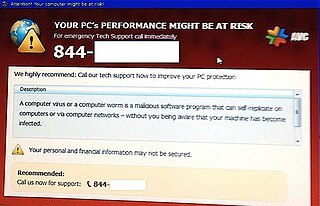
Antivirus software, also known as anti-malware, is a computer program used to prevent, detect, and remove malware.

Spybot – Search & Destroy (S&D) is a spyware and adware removal computer program compatible with Microsoft Windows. Dating back to the first Adwares in 2000, Spybot scans the computer hard disk and/or RAM for malicious software.
Norton AntiVirus is an anti-virus or anti-malware software product founded by Peter Norton, developed and distributed by Symantec since 1990 as part of its Norton family of computer security products. It uses signatures and heuristics to identify viruses. Other features included in it are e-mail spam filtering and phishing protection.

The Windows Registry is a hierarchical database that stores low-level settings for the Microsoft Windows operating system and for applications that opt to use the registry. The kernel, device drivers, services, Security Accounts Manager, and user interfaces can all use the registry. The registry also allows access to counters for profiling system performance.
PGPCoder or GPCode is a trojan that encrypts files on the infected computer and then asks for a ransom in order to release these files, a type of behavior dubbed ransomware or cryptovirology.
Tuxissa is a fictional computer virus hoax made up by Humorix, a humor website on Linux.
Bifrost is a backdoor trojan horse family of more than 10 variants which can infect Windows 95 through Windows 10. Bifrost uses the typical server, server builder, and client backdoor program configuration to allow a remote attacker, who uses the client, to execute arbitrary code on the compromised machine.
Blackworm is an Internet worm discovered on January 20, 2006 that infects several versions of Microsoft Windows. It is also known as Grew.a, Grew.b, Blackmal.e, Nyxem.e, Nyxem.d, Mywife.d, Tearec.a, CME-24, and Kama Sutra.
The Vundo Trojan is either a Trojan horse or a computer worm that is known to cause popups and advertising for rogue antispyware programs, and sporadically other misbehavior including performance degradation and denial of service with some websites including Google and Facebook. It also is used to deliver other malware to its host computers. Later versions include rootkits and ransomware.

A computer virus hoax is a message warning the recipients of a non-existent computer virus threat. The message is usually a chain e-mail that tells the recipients to forward it to everyone they know, but it can also be in the form of a pop-up window.
W32.Navidad is a mass-mailing worm program or virus, discovered in December 2000 that ran on Windows 95, Windows 98, Windows NT, and Windows 2000 systems. It was designed to spread through email clients such as Microsoft Outlook while masquerading as an executable electronic Christmas card. Infected computers can be identified by blue eye icons which appear in the Windows system tray.
RavMonE, also known as RJump, is a Trojan that opens a backdoor on computers running Microsoft Windows. Once a computer is infected, the virus allows unauthorized users to gain access to the computer's contents. This poses a security risk for the infected machine's user, as the attacker can steal personal information, and use the computer as an access point into an internal network.

The Storm Worm is a phishing backdoor Trojan horse that affects computers using Microsoft operating systems, discovered on January 17, 2007. The worm is also known as:

VirusTotal is a website created by the Spanish security company Hispasec Sistemas. Launched in June 2004, it was acquired by Google in September 2012. The company's ownership switched in January 2018 to Chronicle, a subsidiary of Google.
Koobface is a network worm that attacks Microsoft Windows, Mac OS X, and Linux platforms. This worm originally targeted users of networking websites like Facebook, Skype, Yahoo Messenger, and email websites such as GMail, Yahoo Mail, and AOL Mail. It also targets other networking websites, such as MySpace, Twitter, and it can infect other devices on the same local network. Technical support scammers also fraudulently claim to their intended victims that they have a Koobface infection on their computer by using fake popups and using built-in Windows programs.
The Pikachu virus, also referred to as Pokey or the Pokémon virus, was a computer worm believed to be the first malware geared at children, due to its incorporation of Pikachu, a creature from the Pokémon media franchise. It was considered similar to the Love Bug, albeit slower in its spread and less dangerous.
The Fun.Exe virus is of the w32.Assarm family of computer viruses. According to Symantec it registers itself as a Windows system process then periodically sends mail with spreading attachments as a response to any unopened emails in Outlook Express. This virus first appeared in early 2008 and is now recognized by most anti virus programs.
The jdbgmgr.exe virus hoax involved an e-mail spam in 2002 that advised computer users to delete a file named jdbgmgr.exe because it was a computer virus. jdbgmgr.exe, which had a little teddy bear like icon, was actually a valid Microsoft Windows file, the Debugger Registrar for Java.
Duqu is a collection of computer malware discovered on 1 September 2011, thought by Kaspersky Labs to be related to the Stuxnet worm and to have been created by Unit 8200. Duqu has exploited Microsoft Windows's zero-day vulnerability. The Laboratory of Cryptography and System Security of the Budapest University of Technology and Economics in Hungary discovered the threat, analysed the malware, and wrote a 60-page report naming the threat Duqu. Duqu got its name from the prefix "~DQ" it gives to the names of files it creates.

Gruel, also referred to by F-Secure as Fakerr, was a worm first surfacing in 2003 targeting Microsoft Windows platforms such as Windows 9x, Windows ME, Windows 2000 and Windows XP. It spread via email and file sharing networks.






